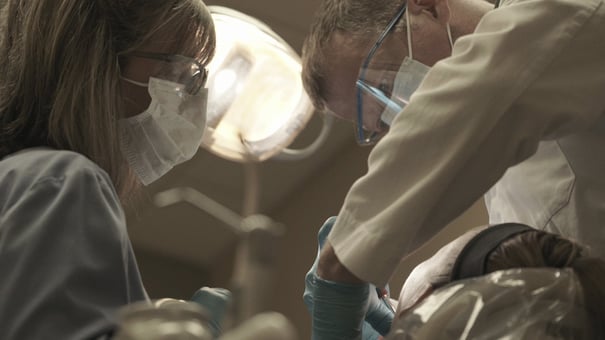The Importance of Gingival Symmetry
by 6monthsmiles, on 11/24/15 10:00 AM
Most of us realize that symmetry is the core element of beauty. The most beautiful people have symmetrical facial features and bone structure that is essentially balanced. These are the people we see in magazines, movies and TV advertisements. A certain amount of symmetry must be present in order for something to be perceived as aesthetically pleasing.
This concept of symmetry is at the heart of cosmetic dentistry. Foundationally, cosmetic dentistry is all about increasing symmetry. Teeth whitening is an attempt to create symmetry and balance between the color of the teeth and the whites of the eyeballs. Teeth appear unhealthy and unattractive when the hue of the teeth does not balance with the whites of the eyes. Porcelain veneers can dramatically improve the appearance of a smile. Tooth color and texture can be optimized and the proportions of the teeth can be idealized. Additionally, veneers can mask tooth wear and minor tooth-position discrepancies. There is one particular dental discrepancy that has traditionally been a major challenge for dentists. It is also a discrepancy that, if not rectified, can prevent a smile from having the symmetry that is required for it to be a true cosmetic success. The discrepancy I’m referring to is uneven maxillary gingival heights.
Most dentists understand that ideally, we want to have the gingival zeniths of the upper central incisors at the same height as each other. The gingival heights of the upper lateral incisors should be about 1mm coronally positioned relative to the centrals. Finally, the maxillary canines should have a height that is essentially the same as the centrals. This configuration is aesthetically pleasing and the cornerstone of an attractive smile. Of course, some patients do not show their gingival margins when smiling. For these patients, the location of the gingival margins is not paramount. But patients that do not show their gingival margins upon smiling are relatively rare.

Uneven gingival margins pose a problem to most dentists because most dentists have very little control over their positions. Some enhancements can be made via periodontal surgery or tissue trimming but the amount of tissue change that can be accomplished is relatively minimal. Ultimately, these gingival margin discrepancies can be traced back to malpositioned teeth. The gingival attachment forms at a specific relationship to the CEJ of a particular tooth. Therefore, when the teeth within an arch are not level and straight, the gingival margins will almost always be in disharmony.
As mentioned earlier, porcelain veneers can improve aspects of the smile and hide some minor tooth position discrepancies, but very little can be done to balance the gingival margins when treating patients with porcelain veneers. It is not uncommon for a dentist to deftly create great veneer preparations and receive fantastic ceramic work back from their lab only to find that once cemented, the patient isn’t thrilled with the final veneer result. Oftentimes the patient can’t quite pinpoint the specific aspect of the smile that is displeasing to them. They will say things like “I’m not sure but something just doesn’t look right” or “They look nice and white but I’m just not happy with the overall appearance.” More often than not, the patient is noticing the lack of gingival symmetry and simply isn’t conscious of it. They see something that bothers them but they can’t describe what it is.
Ultimately, being a good dentist includes the ability to recognize what symmetrical discrepancies exist and also knowing how to correct them. In the words of Dr. Frank Spear, “Figure out where you want the teeth and then figure out how to get them there.” Herein lies the problem for most dentists. Most dentists don’t have the ability to move teeth other than the slight position changes that can be made with a restorative treatment plan. Furthermore, since the large majority of adult patients are unwilling to undergo traditional orthodontic treatment, a referral to an orthodontist is not accepted by most adult patients. This creates a situation where dentists are trying to provide great cosmetic dentistry for their patients but with little or no control over the all-important gingival heights.
Fortunately, many GPs have learned how to provide some orthodontic movement using clear aligners. Aligners have been a real asset for general dentists as they have provided us with a tool that can be used to address tooth-position problems. This also gives us some control over the gingival levels. However, aligners have limitations. It is quite difficult to extrude and rotate teeth with aligners and this can be quite frustrating for dentists and patients alike. Furthermore, the high lab fees associated with aligner treatment limits the number of patients who can accept treatment and also limits the payment options that dentists can provide for their patients.
The Six Month Smiles Short Term Ortho system (www.SixMonthSmiles.com) has emerged as a fantastic solution for general dentists. Short Term Ortho involves the use of tooth-colored brackets and wires to level and align the teeth in an average of just six months. The orthodontic scope is more limited than that of traditional comprehensive orthodontics. The treatment goals of Short Term Ortho are very similar to those associated with aligner therapy and align with the trend of minimally invasive dentistry. However, brackets and wires provide for much more controlled and efficient tooth movement. This gives us the ability to provide the needed changes in symmetry over a very reasonable amount of time. Most gingival level discrepancies can be easily corrected in just three months. This can make our cosmetic and restorative dentistry much more predictable and ultimately the end result is more aesthetically pleasing.
Most dentists want to provide great services for their patients. Cosmetic dentistry, when performed correctly, can be a life-enhancing service. A cosmetic dentist must be able to recognize and diagnose discrepancies in symmetry. Furthermore, a great cosmetic dentist also has tools at their disposal with which they can correct the problems. Gingival margin discrepancies have traditionally posed an unsolvable problem for clinicians. But, like most problems, it can be solved with ample knowledge, effective materials and a systemized approach.






